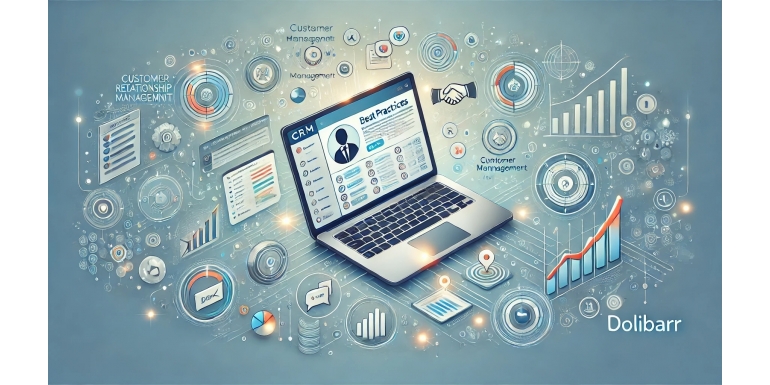
Introduction
In a world where customer satisfaction is a key factor for success, having an efficient CRM is essential for any business. Dolibarr, an open-source ERP and CRM software, provides a comprehensive solution for effectively managing customer relationships.
With its lead management, sales tracking, and task automation features, Dolibarr helps optimize customer interactions and improve loyalty.
In this article, we will explore the best practices for effective customer relationship management with Dolibarr, covering essential features and strategies to implement.
1. Understanding the Importance of a CRM with Dolibarr
1.1. Why Use a CRM?
A CRM (Customer Relationship Management) tool is crucial for:
-
Tracking and organizing customer interactions
-
Automating lead and sales opportunity management
-
Optimizing customer service and improving satisfaction
-
Increasing sales through better relationship management
1.2. Why Choose Dolibarr as a CRM?
Dolibarr is a modular and flexible solution, suitable for SMBs, startups, and freelancers. It stands out due to:
-
An intuitive interface that is easy to use
-
Scalable functionalities through various modules
-
Easy integration with other tools (invoicing, accounting, project management…)
-
An open-source and cost-effective alternative
2. Setting Up Dolibarr for Effective Customer Relationship Management
2.1. Installing and Activating the CRM Module
To use Dolibarr as a CRM, activate the relevant modules:
-
Access the admin dashboard
-
Go to "Modules / Applications"
-
Activate the following modules:
-
Third Parties (Clients and Prospects)
-
Sales Opportunities
-
Commercial Proposals and Quotes
-
Agenda and Reminders
-
Emailing and Marketing Campaigns
-
2.2. Configuring Basic Settings
-
Define customer categories (prospects, clients, partners…)
-
Create sales pipelines to track opportunities
-
Set up user access rights to secure client data
3. Best Practices for Optimal Customer Management
3.1. Centralizing Customer Data
Dolibarr allows all information to be grouped in one place:
-
Contact details and interaction history
-
Associated invoices and quotes
-
Ongoing sales opportunities
Best practice: Ensure that all interactions with a client are recorded in Dolibarr for optimal tracking.
3.2. Automating Lead Management
One major advantage of a CRM is the ability to automate certain tasks to save time:
-
Automatic recording of new leads
-
Follow-up reminders for commercial interactions
-
Automatic reminders for unsigned quotes
3.3. Efficiently Managing Sales Opportunities
With the Sales Opportunities module, you can:
-
Track the sales cycle from the first contact to closing
-
Assign statuses to opportunities (In Progress, Won, Lost…)
-
Analyze the performance of sales teams
3.4. Personalizing Customer Communication
Dolibarr allows sending personalized emails and newsletters. It is recommended to:
-
Segment the customer base for targeted campaigns
-
Create professional email templates to save time
-
Track open and response rates to measure campaign effectiveness
4. Integrating Dolibarr with Other Tools for Better Customer Management
4.1. Connecting Dolibarr to a Customer Support Tool
To provide optimal customer service, Dolibarr can be integrated with ticketing tools such as:
-
Freshdesk
-
Zendesk
-
OSTicket
4.2. Syncing Dolibarr with Email Marketing Software
Dolibarr can be linked with platforms like:
-
Mailchimp
-
Sendinblue
-
Brevo
This enables managing marketing campaigns directly from Dolibarr and automating customer follow-ups.
5. Measuring and Improving CRM Performance with Dolibarr
5.1. Tracking Key Performance Indicators (KPIs)
It is crucial to measure CRM efficiency using KPIs such as:
-
Lead conversion rate
-
Average response time to customer requests
-
Revenue generated per customer
5.2. Analyzing CRM Reports in Dolibarr
Dolibarr provides analytical dashboards that help evaluate CRM strategy effectiveness and identify areas for improvement.
Conclusion
Customer relationship management is a key challenge for any business looking to retain customers and increase revenue. Dolibarr offers a complete and scalable solution, tailored to companies of all sizes.
By adopting the best practices outlined in this article – centralizing data, automating tasks, personalizing communication, and analyzing performance – you can fully leverage Dolibarr to optimize your customer relationship management.
Feel free to explore additional modules and experiment with different strategies to tailor Dolibarr to your business needs!
